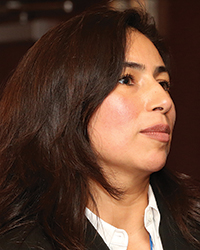New Immigrants, New Research Opportunities
Since the 19th century, immigration and psychology have shaped each other in the United States — for better or worse. Back then, people who attempted to enter the country at Ellis Island faced psychological tests to determine their “fitness.” In the field of education, experts have long scrambled to integrate students from diverse immigrant cultures into American classrooms.

David Rollock
During the cross-cutting theme program “‘Give Me Your Tired, Your Poor’” at the 2015 APS Annual Convention in New York City, David Rollock said that immigrants offer psychological scientists the opportunity to make their field stronger. Immigrant study participants, he said, can expose the limitations of “universal theories” that often are based on data from only a small, homogenous subset of the population (e.g., White college students). And immigrants who do not fit into established ethnic, racial, and religious categories should spur scientists to refine outdated measures and methodologies.
“We also can see that immigration and cultural transition are active, socially constructed processes and not passive things that just happen to people,” said Rollock, who studies minority populations from a clinical perspective at Purdue University. His curiosity about how people rise to the challenge of cultural adaptation has fueled novel studies of diverse Asian immigrant populations.
Previous work has shown that setting and working toward goals helps people feel a greater sense of well-being. Rollock hypothesized that for immigrants, establishing goals might predict mental-health outcomes. When he and his doctoral student Priscilla Lui analyzed data from the National Latino and Asian American Study, they found that Southeast Asian and Chinese immigrants to the United States framed their goals differently from one another and also experienced different health outcomes as a result of those goals. In fact, immigration-related goals contributed as much as other commonly measured constructs, such as English proficiency, to predicting health outcomes. For Southeast Asian immigrants, having experienced political oppression in their countries of origin strongly predicted poor physical health; for Chinese immigrants, a combination of personal and problem-focused goals predicted poor health outcomes (Lui & Rollock, 2012).
Rollock subsequently found differences in goals and the outcomes they predict between Chinese and Indian immigrants in an online survey of 543 Asian international students. His investigations help clinicians distinguish functionally among groups that for too long were lumped together as “Asian immigrants to the United States.”
A Look at the Workplace

Gilad Chen
In a presentation on “Immigrants at Work,” University of Maryland business professor and APS Fellow Gilad Chen admitted that industrial–organizational (I–O) researchers have collected inadequate data on immigrants thus far; only scattered findings exist.
Through work on employees across different countries as well as on expatriates of countries around the globe — a group that shares many characteristics with immigrants — Chen has discovered that workers’ cultural values affect how they respond to leaders at work: Leaders with cultural values that are different from those of their subordinates must work especially hard to bridge cultural differences. Chen also has studied how expatriates adjust in a foreign workplace: Among other patterns, he has discovered that strong motivation to tackle the challenge of cultural adjustment can be extremely helpful for some expatriates who don’t feel supported by their employers. However, the wider the cultural gulf between the expatriate’s own culture and her host culture, the less effective this motivation becomes.
“We have a lot to offer in the I–O psychology literature to anyone interested in cross-cultural encounters,” Chen said, “but we haven’t done that yet in research that specifically looks at immigrants.”
He issued a “call for action” to his I–O colleagues: “We still don’t know a lot about this complex intersection between work and nonwork experiences and human mobility and cross-cultural encounters. If you think about how much an adult invests in their work and career in their life span … it’s mindboggling that we haven’t studied [immigration] more seriously.”
One researcher who has taken the lead in studying this intersection of work and home life is New York University community and developmental psychologist Hirokazu Yoshikawa. He has documented disturbing work pressures on some of the United States’ most marginalized immigrants.
Yoshikawa has examined the development of young children born to immigrant Chinese, Mexican, and Dominican mothers, as well as to US-born African American mothers. Among the immigrant parents, those in the Mexican group were most likely to be undocumented, followed by those in the Chinese and Dominican groups. All of the African American mothers in the study were US-born citizens.

Hirokazu Yoshikawa
Yoshikawa found that Mexican parents — those in the group in which undocumented status was most common — faced special challenges. The Mexican fathers in Yoshikawa’s study worked an average of 12 hours more than a full-time work schedule per week. Nearly a third of Mexican fathers and nearly 40% of Mexican mothers in the study earned less than the legal minimum wage, and only a small minority of the Mexican parents who participated in the study received employment benefits such as paid overtime, sick days, vacation days, and workplace health-insurance benefits.
These hardships had consequences at home. “Family processes like psychological distress, or economic hardship in the home, or more stressed kinds of parenting” follow from the harsh working conditions endured by undocumented employees, Yoshikawa explained.
In spite of the fact that undocumented parents tended to value learning and provide cognitively stimulating activities in the home, the Mexican-origin children in the study — again, those whose parents were most likely to be undocumented — tended to show lower cognitive skills than the other groups (Yoshikawa, 2011).
“Essentially what we showed,” Yoshikawa said, “was that unauthorized status was linked to lower levels of cognitive development in young children as early as age 3 through this combination of lower job autonomy, lower wages, and lower access to [high-quality] childcare.”
Academic Success

Carola Suárez-Orozco
Carola Suárez-Orozco, University of California, Los Angeles, also shared findings related to immigration and child development. She was the principal investigator of a mixed-methods longitudinal study that documented the academic trajectories of 400 newcomer youth from 5 different countries who immigrated to the United States early in adolescence.
By interviewing students and their families, Suárez-Orozco and her colleagues identified five academic trajectories. These included consistently low- as well as high-performing groups of students and a group that showed a slow, steady decline in academic performance — which is typical of adolescents in general, not just of immigrants in particular. A fourth group of students achieved increased academic performance in secondary school after a rough start. The students most often had traumatic experiences prior to migration and demonstrated initial “transplant shock.”
“They were not ready to do school when they first arrived,” Suárez-Orozco said. “But they tended to attend pretty decent schools, and they found a mentor along the way. Those two things made a difference in their lives.”
Of most concern was the fifth group, consisting of 27% of Suárez-Orozco’s subjects: These precipitously declining students essentially “crashed and burned” as a result of a constellation of factors including stress related to long family separations and unauthorized immigration status, difficulties mastering English, and particularly unsupportive schools.
The take-home message, according to Suárez-Orozco? “Resources and contexts matter. The resources newcomer students have — at home in terms of an array of supports, as well as the neighborhood and school contexts in which they land — that will all add up.”
Lessons in ‘Familism’
A presentation by Belinda Campos of the University of California, Irvine, reminded fellow psychological scientists that although immigrants often face challenges while adapting to new cultures, of equal importance are the ways that immigrants enrich their new communities.

Belinda Campos
Campos argued that individualism runs deep in the United States. In contrast, she said, Latino and Asian immigrants often come — broadly speaking — from collectivist cultures with a strong undercurrent of “familism,” which Campos defines as “a cultural ideal that emphasizes interdependent relationships that are characterized by support, connection, frequent proximal physical interaction, and most importantly that priority be placed on the needs of family before the self.” In this family-oriented context, important career and relationship decisions may be made in ways that take into consideration the preferences of family members rather than being primarily based on individual preference.
Familism contributes to better psychological health for people of many cultural backgrounds — even cultural backgrounds that traditionally are not associated with strong traditions of familism. Through a study of 1,245 US students, Campos tested the links between measures of participants’ closeness to family members, perceived social support, symptoms of depression and anxiety, and subjective well-being. She has concluded that closeness and social support connect familism to better mental health.
Recent waves of immigrants from countries that prioritize familism can make the United States stronger, Campos told her audience: “People whose cultural backgrounds emphasize prioritizing others before the self are being incorporated into the US.” With that change comes an “opportunity for cultural shifts that can benefit relationships and health.”
References and Further Reading
Campos, B., Ullman, J. B., Aguilera, A., & Schetter, C. D. (2014). Familism and psychological health: The intervening role of closeness and social support. Cultural Diversity and Ethnic Minority Psychology, 20, 191–201.
Chen, G., Kirkman, B. L., Kim, K., Farh, C. I. C., & Tangirala, S. (2010). When does cross-cultural motivation enhance expatriate effectiveness? A multilevel investigation
of the moderating roles of subsidiary support and cultural distance. Academy of Management Journal,
53, 1110–1130.
Kirkman, B. L., Chen, G., Farh, J.-L., Chen, Z. X., & Lowe, K. B. (2009). Individual power distance orientation and follower reactions to transformational leaders: A cross-level, cross-cultural examination. Academy of Management Journal, 52, 744–764.
Lui, P. P., & Rollock, D. (2012). Acculturation and psychosocial adjustment among Southeast Asian and Chinese immigrants: The effects of domain-specific goals. Asian American Journal of Psychology, 3, 79–90.
Suárez-Orozco, C., Gaytán, F. X., Bang, H. J., Pakes, J., O’Connor, E., & Rhodes, J. (2010). Academic trajectories of newcomer immigrant youth. Developmental Psychology, 46, 602–618.
Yoshikawa, H. (2011). Immigrants raising citizens: Undocumented parents and their young children. New York, NY: Russell Sage Foundation.





APS regularly opens certain online articles for discussion on our website. Effective February 2021, you must be a logged-in APS member to post comments. By posting a comment, you agree to our Community Guidelines and the display of your profile information, including your name and affiliation. Any opinions, findings, conclusions, or recommendations present in article comments are those of the writers and do not necessarily reflect the views of APS or the article’s author. For more information, please see our Community Guidelines.
Please login with your APS account to comment.